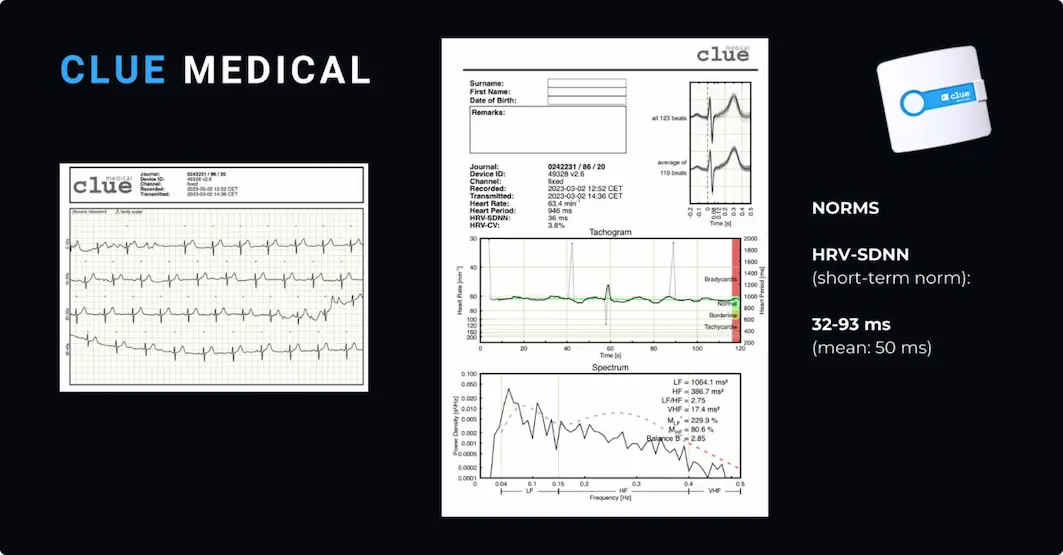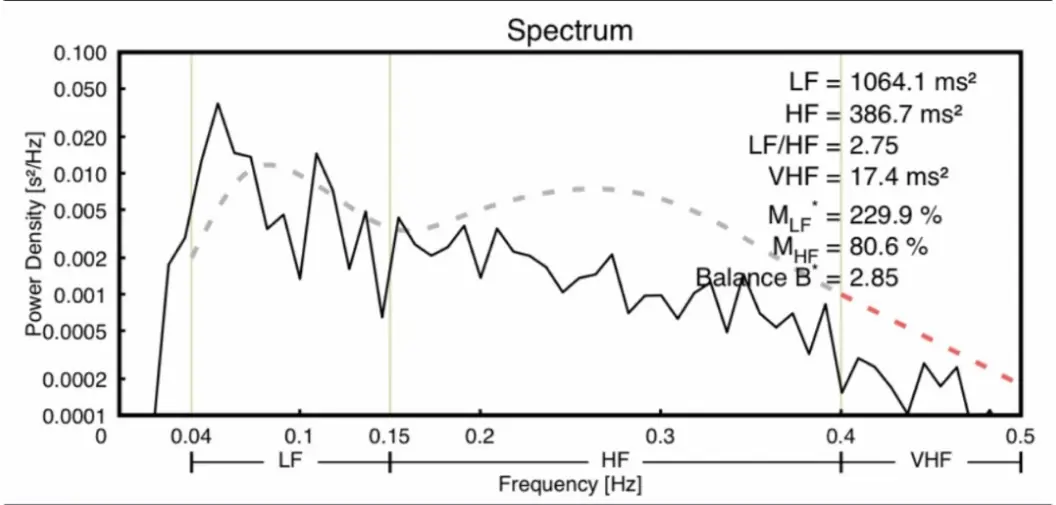Clue Medical Monitoring Sheet
Clue medical makes it possible to produce a differentiated assessment of sympathetic and parasympathetic nervous system activity.
To evaluate the activity of the sympathetic and parasympathetic nervous system as well as their relationship, based on the latest scientific findings for the FFT frequency ranges LF (low frequency 0.04 -0.15 Hz) and HF (high frequency 0.15 - 0.4 Hz), spectral parameters are provided which make it possible to easily record and evaluate deviations from the norm.
We know from physiology that it is mainly the sympathetic nervous system which is reflected in the LF range of the spectrum although vagal (parasympathetic) portions can also be present.
Consequently, the balance determined from the area ratio between the LF, HF and VHF ranges (very high frequency 0.4 - 0.5 Hz) can only be evaluated to a limited extent.
Using a mathematical model developed and introduced specifically for this purpose, clue succeeded in producing a differentiated evaluation. The basis for this is taking into consideration the average heart rate which correlates to the activity of the sympathetic nervous system.
What impact does the autonomic nervous system have on cardiovascular activity?
The new process reflects the control mechanisms and factors, which influence cardiovascular activity with much greater precision and complexity.
This makes it possible to record events such as stress, recovery and the balance between them significantly better and to actually quantify and attribute them.

What does heart rate variability show me?
HRV reflects the heart's ability to adapt to changing circumstances.
The HRV analysis generated by clue medical shows the condition of the heart and the autonomic nervous system, which is responsible for regulation of heart activity. clue medical thus becomes an essential diagnostic and monitoring tool. Via the complexity of the diagnosis, clue medical permits a broad, expanded field of applications in addition to use in cardiology. Thanks to its remarkable mobility and, at the same time, extreme ease of use, the system can be entrusted to a patient for diagnostic and therapy monitoring measures. This cutting edge technology instrument offers high patient compliance.
The measurement recording of the reflected influences of the autonomic nervous system also permits an accompanying use in diseases such as diabetes mellitus, autonomic neuropathy, chronic renal insufficiency/dialysis or psychiatric and neurological disorders.
The scope of applications of clue medical is just as important for sleep and sport medicine, just as it is for the pharmaceutical industry - for example for treatment studies or involved in the development of new medications.
What gets measured:
1) a complete one-channel ECG over a period of 2 minutes
2) a single-average ECG with the characteristic time values
3) average cardiac cycle and heart frequency, absolute (SDNN) and relative (CV) heart rate variability
4) a tachogram of cardiac circle durations including cardiovascular divisions
5) a spectral analysis (FFT) including area measurements derived from such for sympathetic and parasympathetic activity as well as their balance.
Parameters:
- Average heart rate
- Average Heart Period (average duration of the RR intervals during the measurement period)
- pages/Standard deviation (difference between an RR interval and the average RR interval during the measurement period) (norms. 32-93 ms)
- Absolute heart rate variability (SDNN) in milliseconds
- Relative heart rate variability (CV) in % (= SDNN x 100 / Average Heart Period)
- Cardiovascular risk markers (LF, B, LF/HF)

Spectral Analysis:
- pages/LF Low Frequency Range. (0.04 – 0,15 Hz)
(Predominantly representing sympathetic cardiovascular activity, physical and psychological stress) - pages/HF High Frequency Range. (0.15 – 0,4 Hz)
(Predominantly representing parasympathetic activity, and physiological breathing-synchronous heart rate fluctuations of respiratory sinus arrhythmia) - pages/VHF. (0.4 – 0,5 Hz)
(A cardiac risk marker can be attributed to this range with is beyond the activity of the resting components of the cardiovascular system) - LF/HF
- M LF (weighted measure for sympathetic activity, stress, and strain in %)
- M HF (weighted measure for parasympathetic activity, relaxation, and recovery in %)
- Balance B (describes sympathetic (M LF) and parasympathetic (M HF) balance)